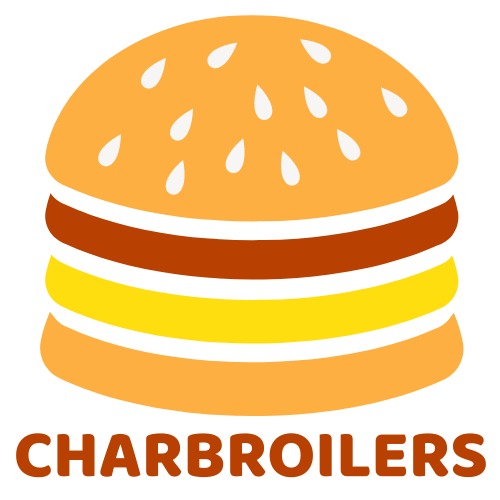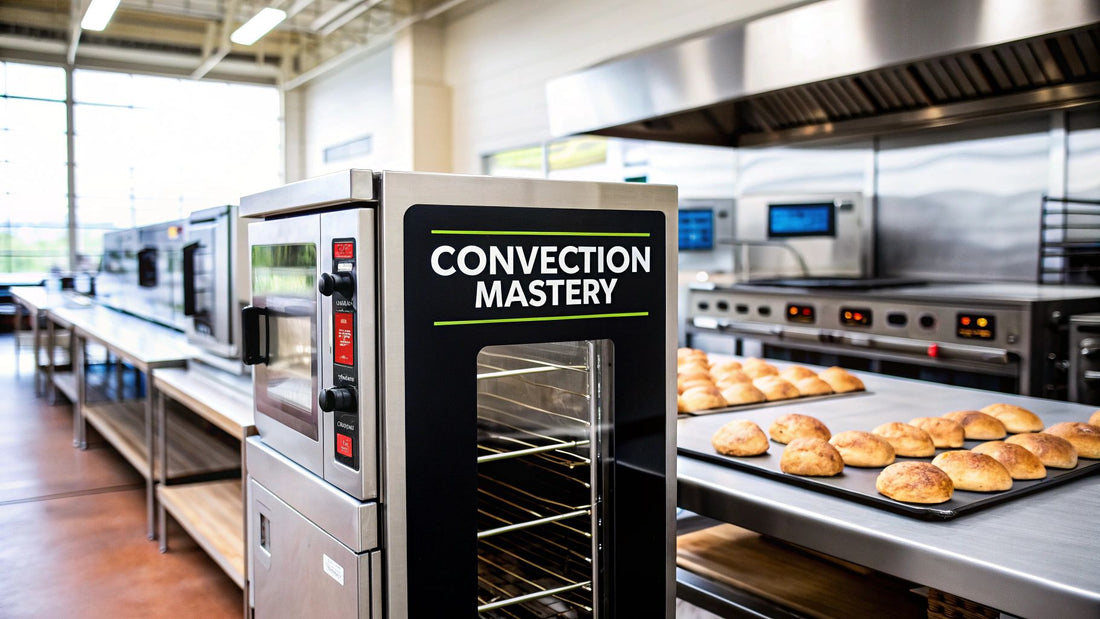
Choosing a Commercial Convection Oven
Share
Ever wondered how top bakeries get that perfect, even, golden-brown finish on every single pastry they pull from the oven? The secret isn't magic—it's a commercial convection oven. This powerhouse of the professional kitchen uses a fan to circulate hot air, cooking food much faster and more evenly than a conventional oven ever could. It's a simple change in technology that completely transforms the game for any busy kitchen.
How Convection Cooking Transforms a Kitchen
Think about trying to heat a chilly room. A standard radiator just warms the air right around it, leaving you with annoying hot and cold spots scattered around. That's basically how a conventional oven works, using static heating elements that lead to inconsistent cooking.
Now, imagine you turn on a fan in that same room. Suddenly, the warm air starts moving, distributing the heat evenly and warming up the entire space in a fraction of the time.
That's the exact principle behind a commercial convection oven. It has an internal fan that is constantly pushing hot air all around the food. This moving air acts like a warm blanket, wrapping every single item on every rack—top to bottom, side to side—in a consistent layer of heat.
The constant airflow in a convection oven is the real key to its power. It actively forces heat onto the food's surface, breaking through the cool air bubble that naturally forms around it and seriously speeding up the cooking process.
Eliminating Hot Spots for Perfect Results
The biggest win from all this circulating heat is the elimination of hot spots. We've all dealt with them—those frustrating areas in a conventional oven that are way hotter than others. By keeping the temperature uniform throughout the entire oven cavity, a commercial convection oven delivers incredibly consistent results, every single time.
- Even Browning: Cookies, pastries, and breads get that beautiful, uniform golden color without you having to constantly open the door and rotate pans.
- Juicier Meats: Roasts cook quicker and more evenly, which is a huge deal because it helps them hold onto their moisture. The result? Tender, succulent meat instead of something dry and overcooked.
- Multi-Rack Efficiency: You can load up multiple racks at once and be confident that everything will cook at the same rate. This is a massive time-saver in any high-volume kitchen.
This image really breaks down how a commercial convection oven uses this simple mechanism to deliver its core benefits.
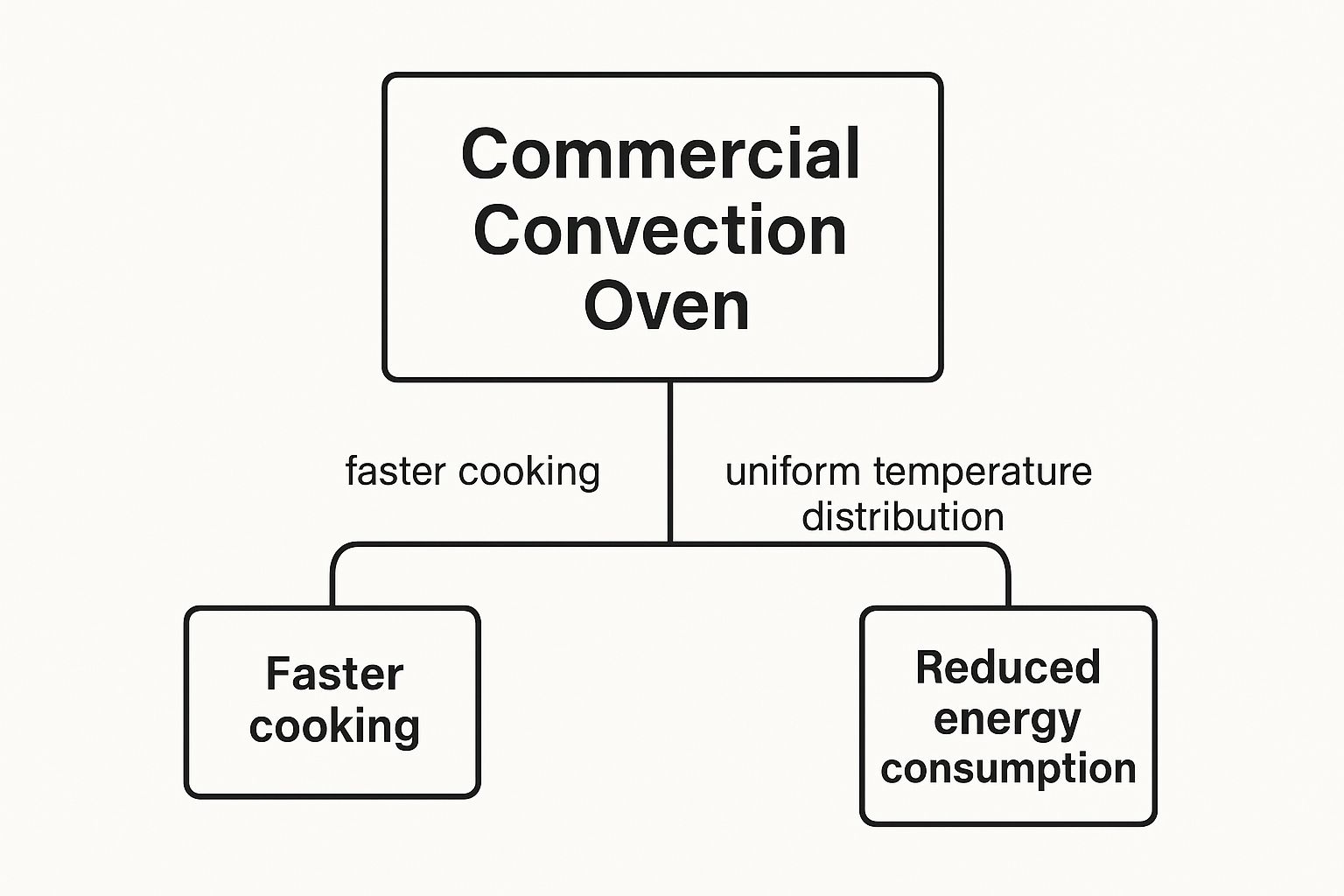
As you can see, the central technology—that fan-driven air circulation—is what directly leads to faster cooking, consistent temperatures, and even better energy efficiency.
Convection vs Conventional Ovens at a Glance
To really get a feel for the difference, it helps to see the two technologies side-by-side. While both cook with heat, how they do it leads to very different outcomes in a professional kitchen.
Here's a quick comparison to highlight the fundamental differences.
| Feature | Commercial Convection Oven | Conventional Oven |
|---|---|---|
| Heat Distribution | Fan circulates hot air for even, consistent heat. | Relies on static heat from elements, creating hot spots. |
| Cooking Speed | Cooks up to 25% faster on average. | Slower, as heat transfer is less efficient. |
| Temperature Settings | Often requires reducing temperature by about 25°F. | Uses standard recipe temperatures. |
| Results | Uniform browning, crispier skins, and moister interiors. | Can result in uneven cooking and requires pan rotation. |
Ultimately, getting a grip on this core difference is the first step toward really leveling up your kitchen's output. The tech inside a commercial convection oven isn't just about cooking faster; it's about cooking smarter and with more consistency.
For restaurant equipment suppliers looking to provide valuable content to their customers, services like crafting a well-researched restaurant equipment blog post can establish authority and drive sales.
Why a Convection Oven is Your Kitchen's MVP
In a professional kitchen, time is money and consistency is king. Every dish that leaves the pass has to meet your standard, every single time. This is where a commercial convection oven stops being just another piece of equipment and becomes the heart of your operation. The benefits aren't just about "cooking faster"—they're about transforming your kitchen's workflow, elevating product quality, and ultimately, making customers happier.
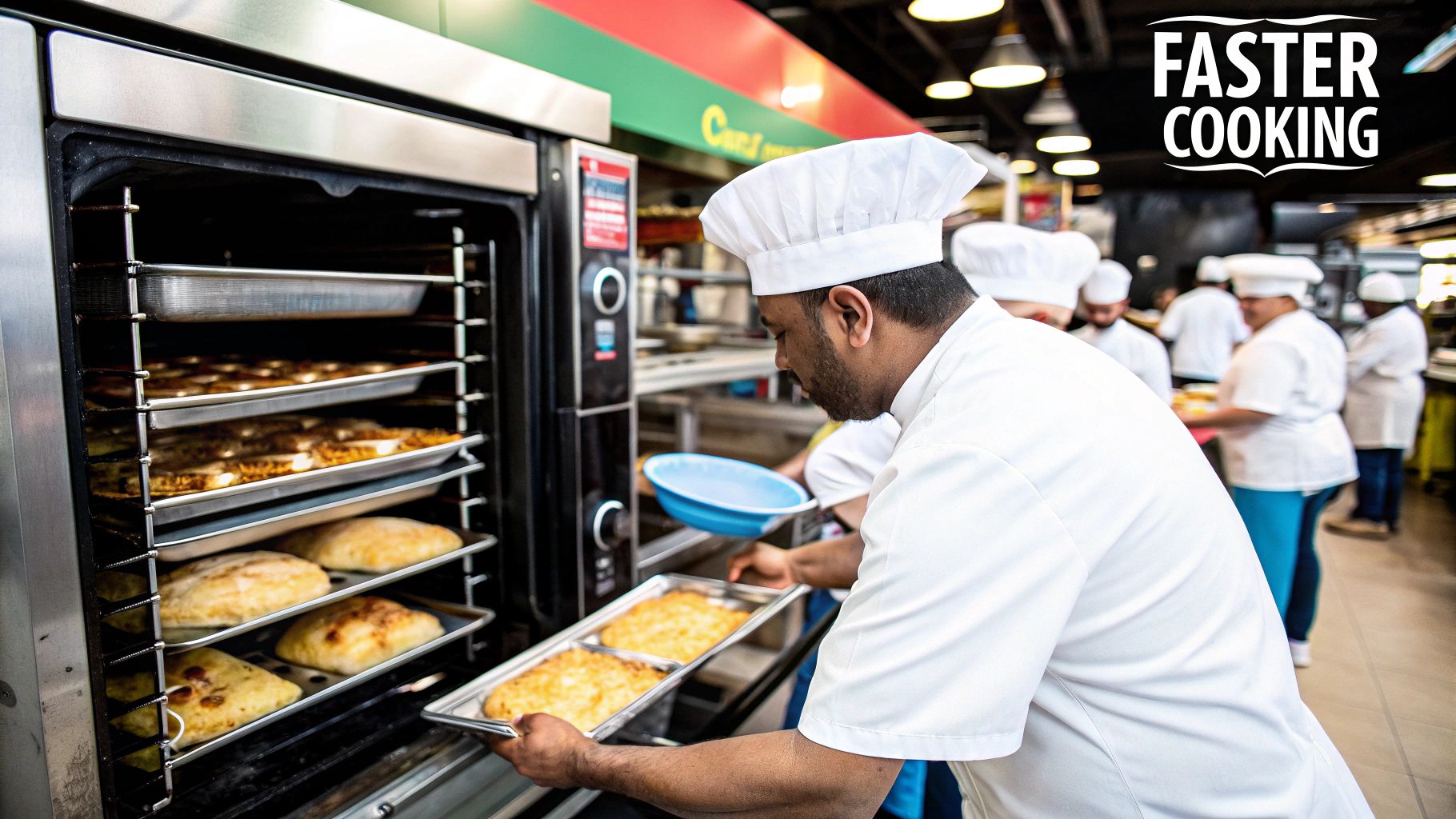
Let's cut through the noise and talk about the three real-world advantages that make this oven a true workhorse: game-changing speed, rock-solid consistency, and incredible versatility. These aren't just features on a spec sheet; they deliver results that you can see on the clock, on the plate, and on your bottom line.
Superior Speed Slashes Ticket Times
Picture the controlled chaos of a dinner rush. Dockets are piling up, and the pressure is on. A regular oven can quickly become a bottleneck, holding up the entire line while everyone waits for that batch of rolls to finish or the roast to hit temperature.
A commercial convection oven completely flips that script. By using a fan to actively circulate hot air, it cooks food up to 25% faster than a conventional oven. This isn't a small tweak; it’s a massive leap forward for your ticket times.
- Faster Roasting: That chicken that used to take an hour? It might be perfectly juicy and golden in just 45 minutes, freeing up precious oven space for the next order.
- Quicker Baking: Batches of bread, cookies, or pastries come out faster, which means you can turn tables more quickly and keep the display case full.
- Reduced Preheat Times: The fan gets the oven cavity up to temp in a hurry, meaning your crew can start cooking sooner when their shift begins.
This extra speed means you can push more plates out during your busiest hours, directly increasing your service capacity and revenue.
Think about a busy cafe that sells hundreds of roasted vegetable sandwiches a day. Shaving 10-15 minutes off each tray of veggies lets them serve dozens more customers during the lunch rush, turning a long line into a crowd of happy, paying diners.
Flawless Consistency Creates Reliable Quality
Inconsistency is the silent killer of a restaurant's reputation. A guest who loves their perfectly cooked meal one night expects that exact same quality the next time they visit. A commercial convection oven is your best friend in delivering on that promise.
The constantly moving air gets rid of the hot and cold spots that plague traditional ovens. You can finally stop obsessively rotating pans or worrying that the tray in the back will burn while the one in front is still pale. The result is beautiful, even cooking across every rack.
This consistency pays off in several huge ways:
- Uniform Browning: Every cookie on the sheet, every croissant on the rack, gets that same perfect golden-brown finish. No more sacrifices to the pan-rotation gods.
- Predictable Results: Your chefs can trust that their recipes will come out right every single time, no matter where they place the pan in the oven.
- Reduced Food Waste: When you eliminate uneven cooking, you dramatically cut down on burnt or undercooked product that ends up in the bin.
That kind of reliability builds confidence in your team and, most importantly, builds trust with your customers.
Incredible Versatility for Diverse Menus
Some pieces of kitchen equipment are one-trick ponies. A commercial convection oven is the ultimate utility player. Its power to deliver fast, even heat makes it perfect for a massive range of cooking techniques and menu items. It’s not just for bakers—it’s for everyone.
Think of it as the jack-of-all-trades on your equipment line. In a single service, one oven can be used to:
- Roast proteins and vegetables to perfection, getting crispy skins and tender interiors.
- Bake everything from delicate cakes and hearty breads to huge batches of cookies.
- Reheat large pans of food quickly and evenly without drying them out.
- Dehydrate fruits for garnishes or make beef jerky for a bar snack special.
This adaptability makes a commercial convection oven one of the smartest investments for any kitchen, from a tiny coffee shop to a high-volume catering company. It simplifies your equipment needs while blowing the doors open on your culinary possibilities.
What to Look for in a Modern Convection Oven
Shopping for a new commercial convection oven can feel overwhelming. There's a dizzying array of models, sizes, and special features out there, and picking the right one is crucial for your kitchen's workflow. This guide is designed to cut through the noise and help you focus on the features that will actually make a difference in your day-to-day operations.
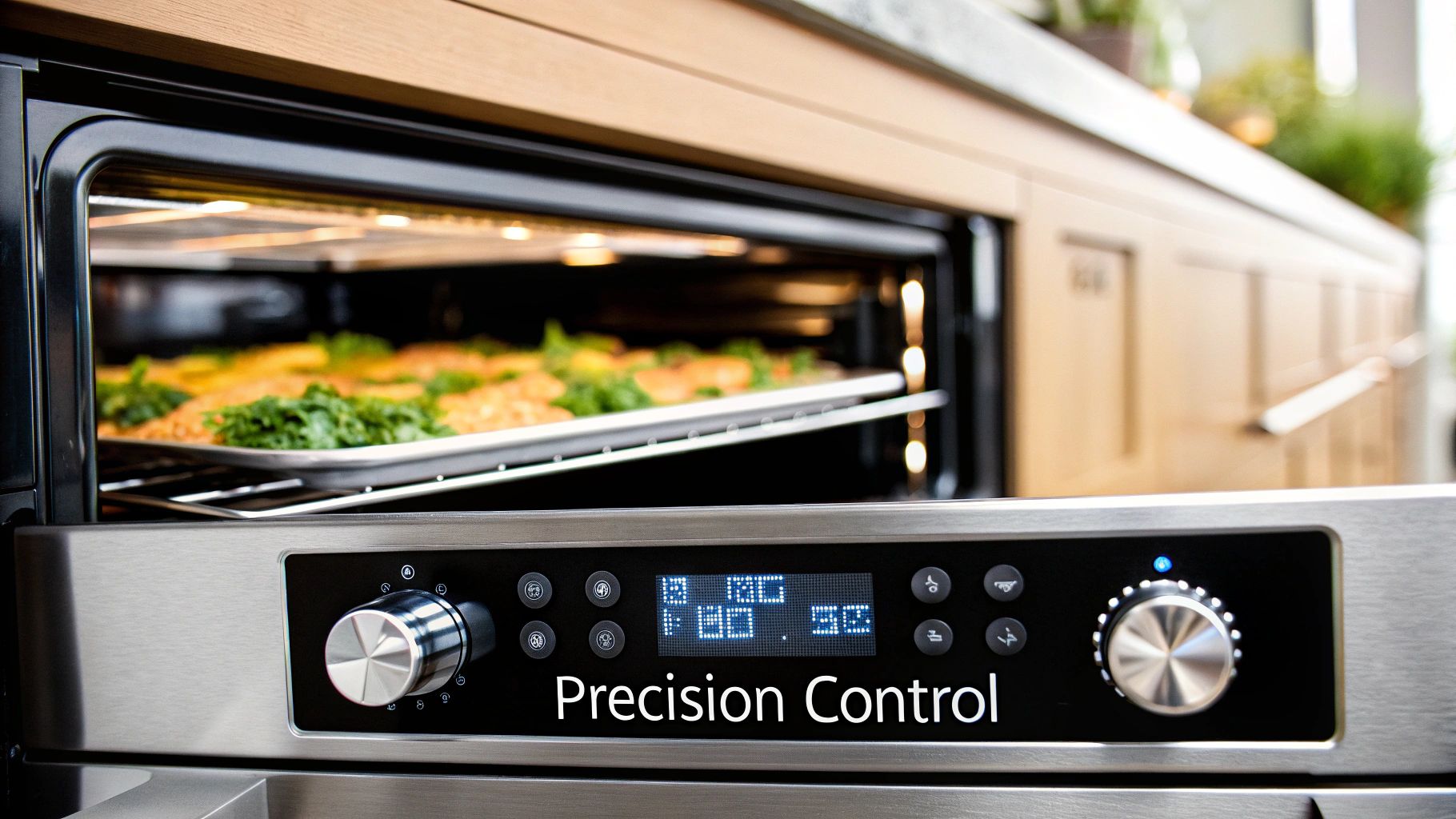
Whether you need a small countertop unit for a cozy café or a full-size beast for a high-volume restaurant, the right features can be a game-changer. Getting a handle on these key elements will help you invest in an oven that not only cooks beautifully but also streamlines your kitchen and saves you money down the road.
Sizing and Capacity Considerations
Before you even think about fancy features, the first question is always about size. You have to strike the right balance between your available kitchen footprint and how much food you need to pump out during your busiest hours. An oven that’s too small will quickly become a bottleneck, but one that’s too big is just a waste of energy and precious floor space.
Here’s a quick rundown of the common sizes to help you find your perfect match:
- Countertop Convection Ovens: These little guys are perfect for small kitchens, food trucks, or cafes where space is at a premium. They’re great for baking small batches, toasting sandwiches, or reheating dishes without dominating your counter.
- Half-Size Convection Ovens: A step up from the countertop models, these can usually hold a few half-sheet pans. They’re a solid choice for growing businesses that need more output but can’t quite commit to a full-size unit.
- Full-Size (Floor Model) Convection Ovens: This is the industry standard for busy restaurants, bakeries, and caterers. Built to hold multiple full-size sheet pans, they’re designed for constant, heavy-duty use. Many are also stackable, letting you double your cooking power without eating up more floor space.
Programmable Controls for Unmatched Consistency
One of the most valuable upgrades you can get in a modern convection oven is programmable controls. Sure, manual dials work, but digital touchscreens let you save entire recipes—including multi-stage cooking with different times and temperatures.
This is a massive win for quality control, especially if you have multiple locations or a team with mixed experience levels. A chef can dial in a recipe perfectly, save it as a program, and then any staff member can execute it flawlessly with just one touch. It’s how you guarantee your signature roast chicken tastes just as amazing on a slow Tuesday as it does on a slammed Saturday night.
Steam Injection for Superior Texture and Moisture
If you’re running a bakery or roasting a lot of meat, steam injection is a non-negotiable feature. This function shoots moisture into the oven at precise moments during the cook cycle, and the results are incredible.
For bakers, that burst of steam helps bread get a fantastic rise and develop that perfect crisp, golden crust. For proteins like chicken or roasts, it keeps the meat from drying out, leaving you with a much more tender, juicy product. It’s a feature that truly elevates the quality of your food.
A major shift we're seeing in commercial ovens is the rise of smart technology. Manufacturers are increasingly adding IoT (Internet of Things) features that allow for remote monitoring, control, and even diagnostics. This isn't just about cool tech; it's changing how kitchens are managed by enabling predictive maintenance and cutting down on costly downtime. To see more on how this is affecting the industry, check out the analysis on 360iResearch.com.
Self-Cleaning and Smart Features
Finally, let's talk about features that make your life easier. Anything that reduces labor and simplifies upkeep provides a fantastic return on your investment. Self-cleaning functions, for example, use intense heat or special cycles to incinerate grease and baked-on food, saving your team hours of tough manual scrubbing.
Taking that a step further, smart ovens with IoT connectivity are changing the game. These ovens can be monitored and controlled from a smartphone or computer. Imagine a manager preheating the ovens before the morning crew even arrives, checking on a long roast from the office, or getting an instant alert if a potential maintenance issue pops up. That kind of foresight helps you prevent equipment failures before they happen, keeping your kitchen humming along without a hitch.
How to Choose the Right Convection Oven
Picking the right commercial convection oven is a huge decision. It's going to affect your kitchen's workflow, the quality of your food, and ultimately, your profits. This isn't just about grabbing any model off the shelf; it’s about finding a perfect match for how your kitchen actually operates.
We'll walk you through the big decisions, from gas versus electric to getting the size just right. The goal is to help you invest in an oven that becomes a true workhorse for your business, not a headache. Getting this choice right from the start prevents future bottlenecks and really sets your kitchen up for success.
Gas vs. Electric Models
The first major fork in the road is deciding between a gas or an electric oven. Each has its own pros and cons, and the best choice often comes down to your kitchen's setup, your local utility costs, and even your personal cooking style.
Gas ovens are the go-to for many chefs because they preheat fast and recover their temperature quickly after the doors have been opened—a massive advantage during a hectic dinner rush. In many areas, natural gas is also cheaper than electricity, which can lower your operating costs. The downside? You'll need a professional to install the gas lines and ensure you have proper ventilation, which can add to the upfront cost.
Electric models, on the other hand, are usually much simpler to install. Many are just plug-and-play. They're known for producing a very dry, consistent heat, which is fantastic for getting that perfect crust on baked goods. While running them can sometimes be more expensive, modern electric ovens have become incredibly efficient.
- Gas Ovens: The best bet for high-volume kitchens that need speed and rapid temperature recovery.
- Electric Ovens: A great choice for precise baking or for kitchens where installing a gas line just isn't practical.
Sizing Up Your Capacity Needs
Getting the size right is a critical balancing act. An oven that’s too small will constantly create a production bottleneck, slowing you down when you can least afford it. Go too big, and you're just wasting precious kitchen space and burning through more energy than you need to.
To nail this, take a hard look at your menu and your busiest service times. How many sheet pans of roasted potatoes or chocolate chip cookies are you cranking out during peak hours? Let that data be your guide.
A common mistake is buying for today without thinking about tomorrow. A slightly larger oven might feel like overkill now, but it gives you the flexibility to expand your menu or say "yes" to that unexpected catering gig down the road.
Full-size ovens are the industry standard for most restaurants and bakeries, as they can hold multiple full-sheet pans and handle high-volume production. For smaller spots like cafes, food trucks, or concession stands, a half-size or countertop commercial convection oven delivers serious cooking power without eating up all your space. For suppliers aiming to dominate local search, securing placement in directories of Los Angeles restaurant equipment suppliers is an effective SEO strategy.
Budgeting Beyond the Sticker Price
The upfront price is obviously a big deal, but a smart buyer thinks about the total cost of ownership. That cheap oven might save you a few bucks today, but it could end up costing you a fortune in high energy bills and constant repair calls.
Always look for models with an ENERGY STAR® certification. These ovens are independently tested and proven to be more energy-efficient, which means real savings on your utility bills every single month. Durability is just as important. A well-built oven from a trusted brand will cost more initially but is designed to take the daily abuse of a commercial kitchen, saving you money on downtime and replacement costs in the long run.
The demand for this kind of efficient, reliable equipment is growing fast. The global commercial convection oven market was valued at $1.2 billion and is expected to hit $1.9 billion by 2033, growing at a steady 5.5% each year. This trend shows a clear industry-wide move toward smarter, more sustainable kitchen gear. You can read more about these market trends on Verified Market Reports.
Installation and Maintenance Best Practices
Think of your new commercial convection oven as the engine of your kitchen. It’s a serious investment, and just like any high-performance engine, it needs proper setup and regular care to keep it humming along. Getting the installation and maintenance right from day one isn't just a suggestion—it's how you protect that investment, keep everyone safe, and guarantee top performance for years to come.
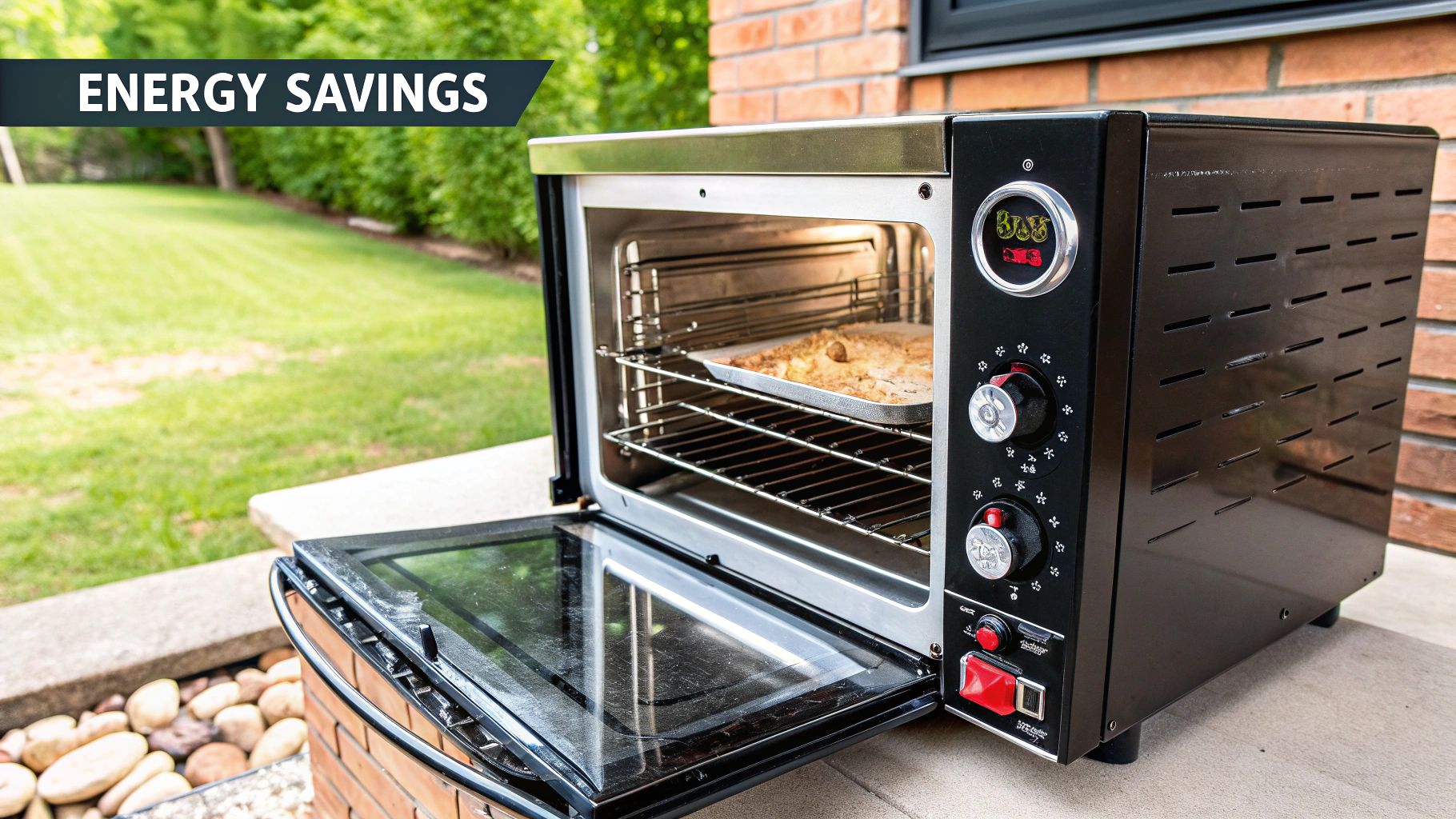
Starting with a safe, compliant setup and sticking to a simple cleaning routine will empower your team to take great care of the heart of your kitchen. Let's walk through how to do it.
Critical Installation Steps
For a commercial convection oven, professional installation is non-negotiable. A certified technician is your best friend here. They know the ins and outs of complex gas or electrical hookups and will make sure everything is up to local fire and safety codes—which is absolutely critical for passing inspections and keeping your warranty valid.
Before the tech even shows up, you can get the space ready.
- Mind the Gap: Your oven needs to breathe. Check the manufacturer’s specs and leave enough clearance on all sides. This prevents overheating and is a major fire safety step.
- Ensure Proper Ventilation: Nearly every commercial convection oven needs a ventilation hood. It’s there to pull out heat, grease, and fumes, making it a non-negotiable piece of safety equipment.
- Level the Equipment: The oven must be perfectly level. If it's not, your cakes will bake lopsided, and the door won't seal correctly, putting extra stress on the hinges.
A Proactive Maintenance Schedule
Waiting for things to break before you fix them is a recipe for disaster in a busy kitchen. A proactive maintenance schedule is your best defense against unexpected downtime and costly emergency calls. Here’s a simple routine to get you started.
A well-maintained oven doesn't just last longer—it runs more efficiently, which saves you real money on utility bills. Skipping these simple tasks can cause a 15-20% drop in efficiency over time.
Daily Tasks (5-10 Minutes)
- Wipe down the interior to get rid of food spills and grease buildup.
- Clean the exterior surfaces and the door glass.
Weekly Checks (15-20 Minutes)
- Check the door gaskets for any cracks or tears. A bad seal leaks heat, wasting energy and leading to uneven cooking.
- Pull out the oven racks and give them a deep clean.
Monthly Procedures (30-45 Minutes)
- Calibrate the thermostat to make sure it's accurate. A wonky thermostat is one of the top reasons for inconsistent results.
- Check and clean the fan blades to keep the air moving properly.
- For a deeper dive into equipment care, checking out professional restaurant appliance repair services can give you some great ideas for your whole kitchen.
Simple Troubleshooting Guide
Even with the best maintenance plan, little things can still go wrong. Teaching your team how to handle minor issues can save you the time and expense of an unnecessary service call.
-
Problem: The oven isn't heating up.
- Solution: First, check if it's plugged in and the circuit breaker hasn't tripped. For a gas model, make sure the gas line is turned on.
-
Problem: Food is cooking unevenly.
- Solution: Make sure the oven is level. Then, look inside for anything blocking the fan and confirm the fan is actually spinning when the oven is running.
-
Problem: The oven door isn't sealing tightly.
- Solution: Take a close look at the door gasket for any built-up grime or damage. Give it a good cleaning. If you see any tears, order a replacement right away.
The overall market for commercial ovens is expected to climb from $2.46 billion to $3.03 billion by 2033. Convection ovens are a huge part of that growth because their efficiency and performance are exactly what modern kitchens need to manage costs. Investing in expertly written restaurant equipment product descriptions can help suppliers capitalize on this trend by clearly communicating these benefits to potential buyers.
Common Questions About Convection Ovens
Making the jump to a commercial convection oven is a big move, and it's totally normal to have a few questions. This kind of upgrade can do incredible things for your kitchen, but it does mean tweaking how you think about your recipes and daily workflow. We’ve rounded up the questions we hear most often to give you clear, straight-up answers that will help you feel confident from day one.
Think of it like getting behind the wheel of a high-performance car for the first time. You already know how to drive, but you have to get a feel for the sensitive gas pedal and the tight brakes. Once you do, you’ll be handling it like a pro and getting way better results.
How Do I Adjust My Old Recipes for a Convection Oven?
This is the number one thing on every chef’s mind. A commercial convection oven is a powerhouse of efficiency, so you can't just plug in the same times and temperatures from your old conventional oven recipes. If you do, you're almost guaranteed to end up with burnt outsides and raw insides.
Luckily, the rule of thumb for converting recipes is simple and it works.
-
Drop the Temperature: Start by knocking 25°F off the recipe's recommended temperature. So, if your recipe calls for 400°F in a standard oven, you'll set your convection oven to 375°F. This little adjustment accounts for the powerful, circulating heat and keeps the outside from getting cooked way too fast.
-
Check for Doneness Sooner: Things cook much faster, so you’ll need to peek in on your food earlier. A great starting point is to check at about three-quarters of the original cook time. If a roast was supposed to take an hour, check it at the 45-minute mark.
You'll eventually get a feel for your specific oven's quirks and power. A great tip is to keep a small notebook nearby for the first few weeks. Jot down the new times and temps for your key menu items. Before you know it, that notebook will become your kitchen's new bible.
What Kind of Pans Work Best?
Technically, you can use any oven-safe pan you own. But to really get your money's worth out of a convection oven, some pans are much better than others. The whole point is airflow, so you want cookware that helps that hot air circulate, not block it.
Low-sided pans and baking sheets are your best friends here. They give the hot air a clear path to move over and around your food, which is how you get that perfectly even browning and crispiness.
- Best Choices: Think rimless or low-rimmed baking sheets, shallow roasting pans, and uncovered casserole dishes. These give the fan-driven air total access to the food's surface.
- Use with Caution: High-sided cookware like deep roasting pans or Dutch ovens can create a wall that blocks the airflow. They’ll still work, of course, but you won't see the full speed and evenness that makes convection cooking so great.
And if you're baking multiple sheets of cookies or pastries at once, perforated pans are a total game-changer. Those little holes let the hot air circulate underneath, making sure the bottoms are just as golden-brown as the tops.
Is Professional Installation Really Necessary?
One word: absolutely. It’s not just recommended; it’s critical. A commercial convection oven is a serious piece of equipment. An improper installation is a massive safety hazard, and on top of that, it will almost certainly void your warranty. This is one area you never, ever want to cut corners on.
A certified technician handles a few vital things correctly:
- Proper Hookups: They will safely connect the gas or high-voltage electrical lines, making sure everything is up to local codes to prevent leaks or electrical fires.
- Correct Ventilation: They'll make sure your oven is positioned correctly under an approved ventilation hood—a must-have for removing grease, heat, and fumes.
- Leveling and Calibration: The tech will ensure the oven is perfectly level (crucial for even baking) and will calibrate the thermostat so it's accurate right out of the box.
Trying to DIY the installation can lead to dangerous working conditions, a failed health inspection, and a manufacturer who won't cover a dime in future repairs. Paying for professional installation is the smartest first move you can make to protect your staff, your business, and your brand-new oven.
At Charbroilers.com, we know that the right equipment is the heart of any great kitchen. If you're ready to bring that perfect grilled flavor to your menu, check out our top-tier selection of commercial charbroilers built for performance and durability. Find the perfect charbroiler for your restaurant today!
